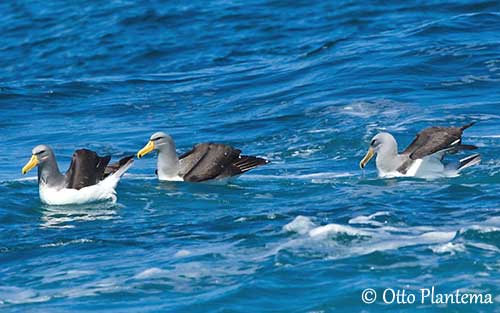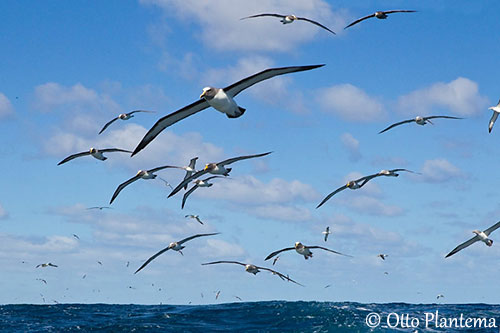
Fr: Albatros des Chatham
Ang: Chatham Islands Albatross - Chatham Albatross
All: Chathamalbatros
Esp: Albatros de las Chatham
Ita: Albatros delle Chatham
Nd: Chathamalbatros
Photographers:
John Anderson
John Anderson Photo Galleries
Otto Plantema
Trips around the world
Simon Tan
PBase Bird galleries
Text by Nicole Bouglouan
Sources:
HANDBOOK OF THE BIRDS OF THE WORLD vol 1 by Josep del Hoyo-Andrew Elliot-Jordi Sargatal - Lynx Edicions - ISBN: 8487334105
BirdLife International (BirdLife International)
New Zealand bird status between 2008 and 2012
Wikipedia, the free encyclopaedia
Page family Diomedeidae
Summary cards
Chatham Island Albatross
Thalassarche eremita
Procellariiformes Order – Diomedeidae Family
INTRODUCTION:
The Chatham Island Albatross was formerly a subspecies of the Shy Albatross (T. cauta). It is endemic to the Chatham Islands, New Zealand, and has a very restricted breeding range on The Pyramid, a small island in the Chatham group. It is listed as Vulnerable.
DESCRIPTION OF THE BIRD:
Biometrics:
Length: 90 cm
Weight: 3100-4700 g
The adult has dark grey upper mantle, whereas back, upperwing and tail are blackish. Rump and underparts are white. The underwing is white too, but we can see a black wing tip and black leading and trailing edges.
Head and neck are dark grey. The bill is yellow with dark spot at tip of lower mandible. There is a narrow orange stripe at base of lower mandible, whereas the upper one is bordered with black at base.
The eyes are dark brown, with a narrow white crescent behind the eye. Lores are black. Legs and webbed feet are pale greyish-pink.
Both sexes are similar.

The immature has paler head and neck. Underwing and undertail show variable amount of grey. The bill is yellow and black, with black tip.
The juvenile resembles immature and has dark grey bill with black tip.
The chick has pale grey down and black bill.
RANGE:
The Chatham Island Albatross is endemic to the Chatham Islands, New Zealand. This species breeds on The Pyramid, a small island of the Chatham Island group.
Outside the breeding season, it ranges in the South Pacific, from Tasmania to Chile and Peru.

HABITAT:
The Chatham Island Albatross breeds on rocky ledges and crevices on the steep slopes of The Pyramid which is their only breeding site (1,7 ha).
Outside the breeding season, it is pelagic and remains at sea in the coastal waters off Chile and Peru.
CALLS AND SONGS: SOUNDS BY XENO-CANTO
The Chatham Island Albatross is silent at sea, but it becomes noisy at the colony where calls are uttered during courtship displays and territorial defence. They produce bill-snapping, harsh croaks and braying sounds and “aka aka aka” calls.

BEHAVIOUR IN THE WILD:
The Chatham Island Albatross feeds on fish, squid and krill. The bird takes the squid when the large shoals come near the surface by night. Albatrosses are mainly surface feeders, but they may perform shallow dives from the surface for food, about one metre under water. Usually, it sits on the water and catches the preys by surface-seizing. This species does not tend to follow the fishing ships.
They can form large flocks up to several hundred birds around The Pyramid.

The Chatham Island Albatross is monogamous and usually pairs for life. They breed in colonies with nests in close proximity. Each pair defends aggressively the nest-site, using biting, bill-clacking or vomiting. The chicks defend themselves using the same displays against intruders.
The adults perform ritualized courtship displays. They dance with raised head and perform bowing and bobbing while producing braying and croak calls. Both mates engage in bill snapping and rubbing. The tail is widely fanned and mutual preening is also reported.
These displays are also used at nest during the incubation and when the mates take turns for incubating or guarding the chick.

The Chatham Island Albatross breeds every year on The Pyramid, on rocky ledges and steep slopes. They can be seen at sea in the surrounding of the small island and also of the Southern Chatham Islands. They can occasionally reach the coastline of E New Zealand.
After breeding, this species migrates and reaches the coastal waters off Chile and Peru. Some vagrants may occur from E Australia, Tasmania and Southern Africa.

The Chatham Island Albatross has powerful flight and is able to fly into the strong winds of the Southern Ocean. It rises in the air by turning into the wind and then, it glides while losing height gradually. However, albatrosses are not able to sustain long flapping flight. They remain on the water until they can take-off.


REPRODUCTION OF THIS SPECIES:
The laying occurs between mid-September and late October.
The nest is typical of albatrosses, a truncated cone with a depression on the top. It is made with mud, grass and moss. It is built on rocky ledges or crevices on steep slopes, and can reach 90-100 centimetres in height.

The female lays a single, large, white egg. Both adults share the incubation during 68-72 days, and perform greeting displays at changeover. At hatching, the chick has pale greyish-white down. It is fed of partly digested fish and squid, and stomach oil produced by the adults during the digestion of their food. The chick fledges about 120-140 days after hatching.
The young birds return to the colony four years later and can breed at 7 years old, but usually later, mainly at 11 years old.

PROTECTION / THREATS / STATUS:
The Chatham Island Albatross suffers harsh weather conditions during the breeding season. Severe storms can kill adults and chicks. Outside this period, storms may destroy the vegetation on the breeding grounds and remove the soil necessary for nest-building. In addition, they have very restricted breeding range.
When at sea after the breeding season, they are threatened by longline fisheries off the west coasts of South America, and oil pollution throughout the winter range.
Translocation of chicks to a protected area in the SW corner of the Chatham Islands is underway between 2014 and 2016, in order to enlarge the breeding range of this species.
The Chatham Island Albatross is listed as Vulnerable. The global population is estimated at 11,000 mature individuals, equating to about 16,000 individuals in total (counts 2008 – 2011).

